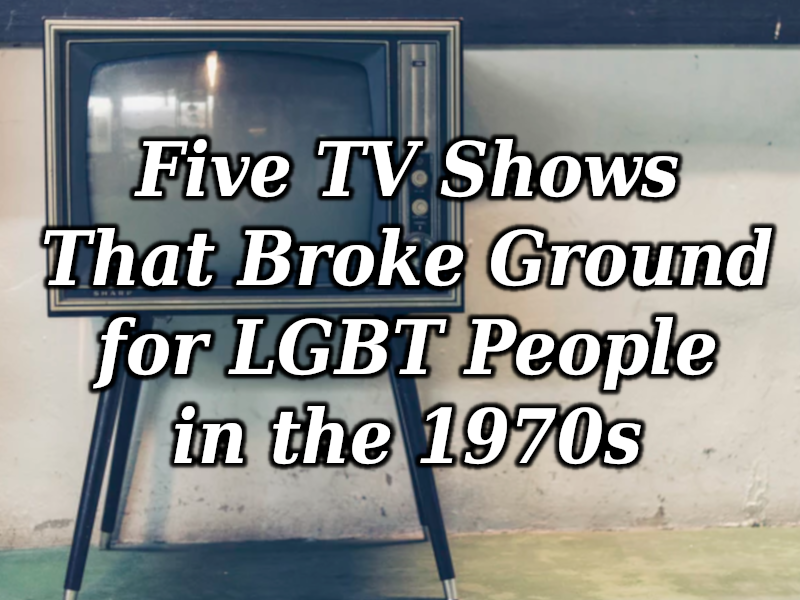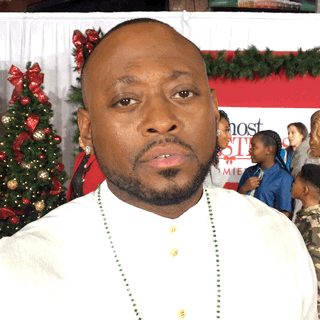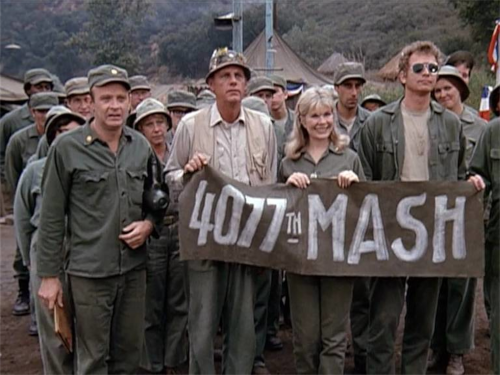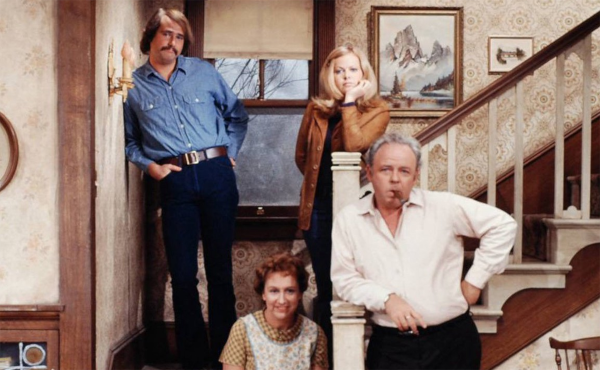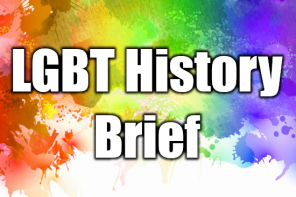Ah, the 70s – disco, sequins and Mellow Yellow. The decade of polyester also gave us a slew of political and cultural upheaval. From the ongoing conflict in Vietnam to President Nixon’s effort to dismantle welfare support and resistance to mandatory school desegregation plans such as busing.
Society was undergoing a major shift. Part of that shift had to do with a conservative backlash against what they saw as entitlement. At the same time, a more progressive part of the population began pushing even harder for things like the Equal Rights Amendment and better protections and a more inclusive culture for people who identify as a part of the LGBT community.
The Stonewall riots had swept through New York in 1969. Those riots set off a domino effect elsewhere in the country. Gay, lesbian, bi-sexual, transgendered and non-binary people from all walks of life began coming forward to demand crazy stuff like equality and respect.
During this time, television was also undergoing a major transformation. Sitcoms and dramas began to reflect the issues and challenges people were dealing with in their real lives. Shows like All in the Family and The Jeffersons confronted issues like race and sexual assault for the first time.
Television had become a powerhouse of influence and a catalyst for change. Several shows debuted and became classics of American television history. The 1970s saw television changing with the times. The public still loved the fantasy level wholesomeness of Leave It To Beaver and Happy Days, but they also wanted more realism. Shows like Good Times, All in the Family, The Jeffersons and M*A*S*H* brought real world issues – and humor – to the small screen.
Political and social issues running the gamut from adoption and interracial families to rape and war began appearing on TV for the first time ever. In some cases, the public outrage was intense. In 1975, Richard E. Wiley, the FCC Chairman at the time, addressed the Senate and House Communications and Commerce Subcommittees regarding the state of television. Wiley introduced the Family Viewing Hour for prime-time. Essentially it mandated that all shows aired before 9 p.m. should be family friendly fare.
Since the networks had agreed to this suggestion, it was implemented in the 1975 television season. Longtime hits like All in the Family were pulled from their usual time slots and moved to later air times. In the days before VCRs and DVRs, this reduced viewership and impacted ratings.
More importantly, writers and artists felt it also affected their First Amendment rights. In the end, television powerhouse Norman Lear mounted a lawsuit. The lawsuit trundled through the system until 1976 when United States district court Judge Warren J. Ferguson declared the Family Viewing Hour null and void. Ferguson agreed it was a good idea in theory but it was simply unconstitutional.
Establishing that TV as an art for was protected by the First Amendment made it easier for program to pursue this kind of controversial, but often enlightening, programming. In the wake of that decision, many shows went on to double down on episodes that were more than entertainment. During this time some shows also began to present people from the LGBT community in a different light.
There were dozens of milestone moments in the television of the 1970s. We’ve gathered seven of the most powerful moments. These shows did more than entertain the public. They helped construct a bridge between different groups. They gave people insight into what it was to live in someone else’s shoes.
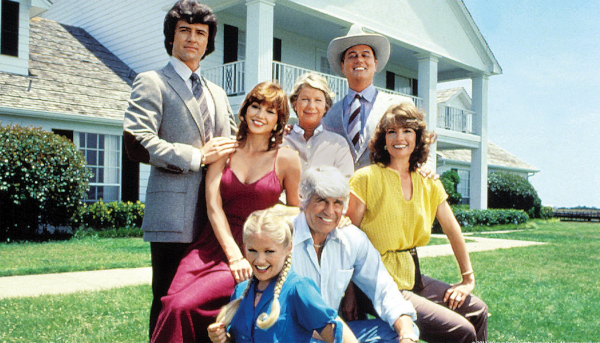 Dallas
Dallas
Fun Fact: Dallas originally aired as a mini-series with no plans for expansion. Public support and viewership of that mini-series was so strong that the show went on for 14 seasons and had an undeniable impact on the culture at the time. While the show is primarily associated with the 80s, it didn’t waste time tackling controversial issues from the beginning. The show debuted in 1978 and never shied away from hot-button topics.
Kit Mainwaring, played by Mark Wheeler, was only on two episodes of the iconic show, but his character made headlines. Kit is introduced right as he’s getting ready to marry Lucy Ewing, niece of series powerhouse J.R. Ewing. Over the course of the two episode story arc, Kit comes out as being gay. Or, well, almost gay.
At first, he confesses to Bobby, one of Lucy’s uncles. Kit makes the tearful confession because he wants to call the wedding off since he doesn’t want to hurt Lucy. He confides that the two slept together and “nothing changed”. “It didn’t change anything,” Kit says, “I’m the same person today I was yesterday. I’m still a homosexual. It’s just not fair for me to marry her.”
One of the most interesting things about the show is the almost cringe-worthy overuse of the world ‘homosexual’. No character – including Kit – ever uses the word gay. It’s always ‘homosexual’, which gives a decidedly clinical feel to the admission.
Other than that, the show holds up surprisingly well. Bobby Ewing, the show’s moral compass character, is sympathetic for Kit in spite of the fact his confession threatens to break the near t of his niece, Lucy.
J.R. Ewing, the show’s flagship Bad Guy, is angry and determined to force the marriage forward since the union spells financial good fortune for the family. His advice is almost charmingly clueless: “You’ve made mistakes in the past, Kit. There’s no sense in repeating ’em. Like they say, there’s nothing like the love of a good woman to keep a man’s feet firmly on the right path.”
In the end, both Bobby and Lucy Ewing accept Kit for who he is and the wedding is, in fact, called off. The writers used the Good Guys of the Dallas cast to treat Kit with respect which sent clear messages to its viewership. When confronted with J.R.’s sneering comments about whether or not Kit is ‘man enough’ to stand up to him, Bobby Ewing shuts him down with the statement “Kit Mainwaring is more a man, J.R., than you will ever be.”
In the end, though, it’s not about how much Babby or Lucy accept and stand up for Kit. The show went that extra mile and showed some insight into how true acceptance is a deeply personal issue. At one point, while Kit is confessing everything to Lucy he breaks it down and effectively defines what true acceptance is. “I’m not gonna change,” he says. “I’m tired of trying. I’ve got to learn to like myself the way I am.”
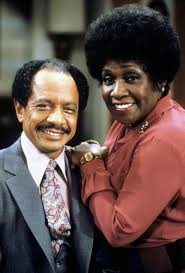 The Jeffersons
The Jeffersons
The Jeffersons was a spin-off of the wildly successful All in the Family which was, in its own right, groundbreaking television. Since All in the Family was known for pushing boundaries and breaking new ground, controversy was nothing new for the writers and actors of The Jeffersons. For example, the show was the first to feature regularly recurring characters who were in an interracial marriage. In the show, the Willis couple includes Helen (played by Roxie Roker) who is black, married to Tom (played by Frank Cover) who is white. This inclusion seems commonplace today but, at the time, was literally groundbreaking.
While LGBT themes and characters weren’t a mainstay in the show, the issues did crop up. In ‘The Breakup: Part 1’, George Jefferson’s son, Lionel, experiences difficulty while writing a paper for college on homosexuality. The issue is never fully revealed except to say they professor demands a “flawless” rewrite. In the end, George buys a professionally written paper for Lionel to turn in and the focus of the episode changes to the ethics of buying college papers.
Later in the series run, however, the writers take a closer look at an issue truly progressive at the time: transgender people. In the 1977 episode, “Once a Friend”, George finds a note that ‘Edie Stokes’ dropped by. George assumes the name is misspelled and that it refers to Eddie Stokes, an old Navy buddy.
George turns up at the hotel looking for his friend Eddie and instead finds a woman. As George goes through the room attempting to ‘find’ Eddie, he walks to the closet and says “Okay, Eddie, time to come out of the closet.” That’s when Edie says “I’m already out of the closet, George.”
When George realizes his friend Eddie is now a woman named Edie he reacts in a typically over-the-top, gymnast level Sherman Helmsey manner. As the episode goes on, George’s wife becomes suspicious that he is dating this woman and George is pressed to prove to her that Eddie is now Edie. His missteps include recruiting a friend to dress in drag to trick his wife but that plan fails spectacularly.
In the end, Edie comes to the apartment to confront George and sees Wheezie. During the confrontation, Wheezie remarks “At least this time you hired a woman to play the part” George responds “This ain’t no woman” and Edie is quick to slide in an “Excuse me?”
In the end, George apologizes and agrees the two are still friends. Edie asks him to call her by her true name and George agrees, reaffirming their friendship.
M*A*S*H
The series M*A*S*H focused around the people who served at the 4077th Mobile Army Surgical Hospital (M*A*S*H), a fictional medical outpost during the Korean war. M*A*S*H went on to air from 1972 to 1983, more than three times as long as the war in which it was set.
The show mixed comedy and drama, often as a way to drive home the seriousness of war as well as the enduring human spirit. During their run, the show addressed plenty of heavy-hitting issues. When it comes to LGBT connections, many people automatically think of Maxwell Q. Klinger, played by Jamie Farr. While Klinger did dress in women’s clothes he was never presented as or described himself as being transgender. His cross-dressing was always framed as his attempt to get a Section 8 discharge in order to escape being in the war.
Klinger aside, the 4077th did deal with serious issues regarding the LGBT community and how they were seen and reacted to within the armed forces. In the 1974 episode “George”, a serviceman is brutally attacked and beaten by members of his own unit when they learn he’s gay. While receiving treatment, he confides in doctors Hawkeye and Trapper and the conversation is overheard by Major Burns.
In the 1970s, being gay was considered an offense in the armed forces. Soldiers who were outed were dishonorably discharged and could be subject to punishment by a court-martial. essentially, it spelled the end of that person’s military career as well as leaving a black mark on their record which followed them long after they left the military behind.
In the show, both Hawkeye and Trapper are supportive of their patient but understand why he wants to keep the reason he was beaten under wraps. Major Burns, on the other hand, represented the current climate at the time and immediately begins to initiate the process to have the serviceman formally discharged. Hawkeye and Trapper learn of Burns’ plans and step in first to plead the young man’s case. When an appeal for empathy is rejected, the doctors threaten to blackmail Burns by exposing the fact that he bought the answers to his medical school admission test. Burns drops the matter and the serviceman is moved to another unit, hopefully to make it to a better life.
Maude
Maude was another spin-off of All in the Family and featured Bea Arthur as Maude. Maude was essentially the antitheses of Archie Bunker. She was a strong, educated, outspoken and extremely liberal woman with no reservations about speaking her mind and no intention of apologizing for anything.
As its own show, Maude ran for an impressive six seasons. During the course of the show, a handful of episodes directly addressed issues surrounding the LGBT community. In an early episode Maude befriends an author who happens to be gay. The friendship and his orientation aren’t hyped up for comedic effect but instead is presented as an interesting aside and not the character’s defining feature.
In ‘The Gay Bar’, Maude’s husband and some of his friends learn about a gay bar in the area. The men band together to protest the bar and end up calling themselves Fathers Against Gay Society, or F.A.G.S. for short. Maude immediately takes issue with their plan and calls them out. “You just want to persecute people you don’t understand,” she tells them.
As is usually the case in situations like this, Maude ends up fighting primarily with their neighbor Arthur. Throughout the show, his character played perfectly off Maude’s super liberal extreme. The two fight back and forth – and take a trip to the bar in question.
In the end, it turns out the bar isn’t breaking any local laws because it’s located just outside city limits. Maude’s husband then drops his protest. The law is the law, he tells her, and if there’s no law prohibiting the bar, he isn’t going to object. He doesn’t experience any personal growth in terms of understanding gays people, but his respect for the law means he respects them on at least that level. For Maude, that means he can be tolerant and that’s enough. Conservative and Liberal, Maude’s relationship with Arthur was used to show ways in which liberal and conservative people could find middle ground.
The long-lasting effect of Maude is more than just the legacy of the show. Bea Arthur went on to start in other shows, icnluding a one-woman show on Broadway and, of course, her iconic character on The Golden Girls. Arthur was an advocate for the vulnerable throughout her life, with a special focus on animals. She also bequeathed $300,000 to the Ali Forney Center, a New York City organization that provides housing for homeless LGBT youths. In 2017, the center opened the Bea Arthur Residence as an 18-bed residence in Manhattan for homeless LGBT youth.
All in the Family
When you think of progressive shows from the 1970s, you’d be forgiven if All in the Family didn’t come immediately to mind. The patriarch of the show was Archie Bunker, played by Carroll O’Connor, who was known for being a lovable – but stubborn, bigot. Bunker had something to say about everyone from ‘the Jews’ to ‘the colords’ and he reigned supreme from his armchair – at least in his own mind.
While Archie played the Bad Guy, absolutely everyone else in his world played the opposite. His wife, daughter, son-in-law, neighbors and one-off characters were all designed and crafted to be a counter-point to Bunker’s reliable ignorance. During its run, the show aired more than half a dozen episodes dealing with various aspects of LGBT culture. In one episode, Archie finds out one of good friends, a pro American football player and ‘All-American drinking buddy’ is gay. According to reports, then-President Nixon watched the episode and panned it as ‘distasteful’.
In other episodes, gay characters are introduced as a way to show Archie’s emotional growth. In one episode, Archie and Edit learn that Edith’s cousin Liz was in a lesbian relationship with a woman named Veronica. They don’t discover this, however, until after Liz passes away and Veronica reveals the truth at the funeral. At one point, Archie demands that Veronica give him a tea set Liz had left behind and threatens to sue her over it. When Veronica tells him that by taking legal action, he will effectively out her and ruin her teaching career, Archie relents.
The show also featured a recurring character, Beverly LaSalle (played by Lori Shannon) who was a drag queen. In Beverly’s debut episode, Archie saves her life by performing artificial respiration while under the assumption LaSalle is a ‘real’ woman. When Archie discovers the truth, he is embarrassed by media attention but he and Beverly ultimately remain friends. In a later episode, Archie sets a friend up on a bling date with LaSalle as a joke which ends badly, but where Archie does gain some insight. Beverly’s character is resurrected in 1977 for the final time when her murder becomes the focus of a two-episode story arc that leaves Archie’s wife, Edith, questioning her faith. Having a recurring character who was a drag queen and who had such an impact on the family was ground breaking at the time. The episodes dealing with her murder, and the effect it had on Edith’s religious outlook was also seen as scandalous.
The 1970s were undeniably a time of social upheaval and societal change. Nowhere is this more evident than in the popular television shows at the time. During the 70s, TV was still emerging as a media form worth paying attention to. It was a time when writers were testing and pushing the boundaries of what was acceptable and what wasn’t.
Powerhouse shows that commanded top ratings like All in the Family, M*A*S*H and others did more than entertain and distract viewers. These shows helped to stoke the flames of the revolutionary spirit reborn in the 1960s. As the 70s wore on, landmark moments such as Roe v. Wade, the reality of war and the rise of the Equal Rights Amendment movement were reflected in and sometimes inspired by what writers, producers and actors were creating for the American public.
If nothing, the 70s taught us the true power of television. It was the dawn of the most iconic American shows not only because of the hard work that went into them. It was also because the shows finally reflected a more realistic image of what America was – and what it could be.

